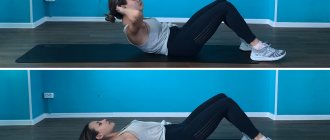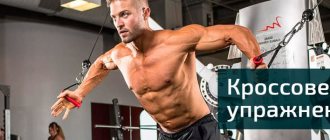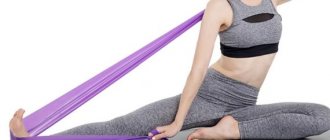Beautiful female belly with a hollow in the middle
Diastasis (from Greek diastosis) is separation, stretching, thinning, interval. We will talk about the divergence of the linea alba, which connects the rectus abdominis muscles.
The linea alba is not a muscle
. This is connective tissue, which consists of dense collagen and elastic fibers.
Normal (left) and overstretched linea alba
Normally, in women and men, the width of the white line is 0.5 - 3 cm. Anything more is classified as diastasis of the rectus abdominis muscles, that is, an increase in the distance between the left and right rectus muscles.
The divergence of the rectus abdominis muscles is essentially reminiscent of a seam on clothing. If the seams separate, the parts no longer fit tightly together. The same thing happens to the linea alba when the collagen stretches.
Contrary to claims about the benefits of exercise, diastasis does not go away on its own. Only surgery can help cope with this condition.
We at Platinental eliminate diastasis using a unique technique that has no analogues in Russian surgical practice.
What is the difference?
- We perform surgical treatment of diastasis of the rectus abdominis muscles without incisions, using endoscopic access,
- if it is necessary to remove excess skin, we perform the procedure through a small 4-centimeter incision below the bikini line; carefully mask the seam,
- we form a beautiful and flat stomach with abs; We emphasize the female belly with a small vertical hollow in the middle.
- We know how to bypass the temporary difficulty in breathing that is typical for such operations, and thereby speed up the recovery period.
From this article you will learn how to independently understand whether there is diastasis of the white line of the abdomen, why diastasis is dangerous and why it cannot be cured at home.
First, we will talk about diastasis itself and the health risks associated with it. Then we will introduce you to the latest surgical practices for suturing diastasis of the rectus abdominis muscles and its aesthetic correction.
Reliable signs of diastasis
Diastasis has one peculiarity. Even if you have a pumped-up and flat stomach, literally half a mug of water radically changes the situation, and your stomach looks like it would if someone was never friendly with sports. The anterior abdominal wall protrudes, the navel falls out.
The appearance of the abdomen is determined by the location and degree of diastasis: in some it manifests itself as a “bloated” abdomen, in others – an inverted navel.
Do I need to wear a brace, bandage or elastic bandages?
The postpartum bandage has been used at all times. Abdominal support during pregnancy and immediately after it helps in some cases, you just need to wear it correctly. This will give stable support to the abdominals and lower back.
But even if you tighten the muscles tightly using a clamp, it does not guarantee that the white line will recover and remain in the same place. That is why you should not rely on a retainer or elastic bandages to return everything to its place, otherwise you will have to wear it constantly and for a very long time.
Remember that diastasis occurs due to excessive stress within the abdominal cavity and pelvis. This is pressure that the body cannot withstand, although it should. A brace and brace will not fix the problem; they will simply bring the two pieces back together after they have come apart, but will not restore the connective tissue between them. First you need to restore balance to the whole body and use the core muscles to remove diastasis.
Diastasis is dangerous due to its consequences
Usually people come to surgeons with a complaint about an unsightly “pregnant” or “beer” belly. But diastasis is dangerous not because of aesthetics, but because of its health consequences.
Sooner or later, diastasis will be joined by an abdominal hernia, when fat or a small fragment of intestine comes out between the stretched fibers of the linea alba. A hernia is formed if you torment yourself with loads and intense training: pumping up your abs, doing squats, lifting weights.
A hernia with diastasis is a time bomb that carries the risk of strangulation and necrosis. Any necrosis is treated by emergency removal of the strangulated area, and in the case of the intestines causes lifelong problems.
The mechanism of formation of abdominal hernia.
A second pregnancy with diastasis of the abdominal muscles carries the risk of oxygen starvation in the child and weak labor.
The disease manifests itself not only externally. Due to changes in the anatomy of the abdominal cavity, organs are displaced and their activity is disrupted. Therefore, the presence of diastasis is usually accompanied by numerous digestive disorders from the intestines - spasms, lower back pain, bloating, flatulence, constipation, a feeling of fullness in the abdomen. Over time, these symptoms intensify and include urinary incontinence.
Gymnastics for children 6-9 months
In addition to the exercises already described:
Breathing exercises are done on your back, on your side, or start while sitting.
Simultaneous and alternate abduction of the arms to the sides, upwards, grasping movements with the arms.
All exercises for the legs are performed: “stomps”, sliding steps, circular movements of the legs, alternating flexion and extension.
A new exercise is introduced: cycling.
Starting position: on your back. With the child's legs bent at the hip and knee joints, circular movements are performed, reminiscent of the movement of the legs while riding a bicycle.
In a sitting position (in a tailor's position, when the feet are joined or in a Turkish position), the child is rocked using a toy and encouraged to stretch after it.
Try in every possible way to encourage your baby to actively turn from back to stomach and back.
An exercise aimed at developing crawling skills is useful. During this period of time, you can help the child by substituting your palm as a support.
Exercises are performed to develop walking: stepping from foot to foot is stimulated, while the adult first supports the child’s armpits, and subsequently, the hands of both hands.
In exercises on the ball: you can use swinging on it in a sitting position.
How to determine abdominal diastasis yourself
To check your stomach yourself and recognize diastasis, you need to lie on a flat surface and bend your knees. Place one hand behind your head. Then as you exhale
lift your upper body as if doing abs. This makes it easier to detect the boundaries of the rectus abdominis muscles. With your other hand, feel the middle of your stomach, between the abdominal muscles. Diastasis is felt especially well in the navel area, since anatomically the white line of the abdomen is wider in this place.
And don’t be alarmed when you find a discrepancy - if the distance between the muscles does not exceed 3 centimeters, everything is fine. More means you need to schedule an appointment with your surgeon. You decide for yourself whether to have surgery or not, but it is necessary to make a diagnosis.
On the left is diastasis of the white line of the abdomen, on the right is a normal, healthy abdomen.
Gymnastics for children from 0 to 3 months
The optimal age at which it is recommended to start a course of massage and gymnastics is discussed in the article “general principles of massage.” Massage and gymnastics for children of the first year of life
Breathing exercises
Breathing exercises are very important for babies of this age. They promote the development of respiratory muscles, the physiological abilities of the respiratory system, its reserve capabilities, and serve as the prevention of respiratory diseases.
Starting position: the child is in the mother’s arms, facing her. Apply rhythmic pressure with the palm of your hand on the child’s back, moving the palm from the neck to the lower back.
Starting position: the child lies on his back. Alternately moving the handles to the side and up, starting from three months you can perform this exercise with two handles at the same time.
Reflex exercises
Infants have a certain physiological feature of the nervous system - the presence of unconditioned reflexes that appear and disappear at certain times.
Thus, a special group of exercises can be distinguished for infants. These are reflex exercises. They are based on the special evocation of certain unconditioned reflexes.
Naturally, no one will induce the Moro reflex as an exercise (a loud blow on the surface on which the child is lying, while he makes a “hugging” movement).
But some of them, for example the Babinski reflex (special stroking of the foot) or the support reflex are very useful as developmental exercises.
The number of repetitions of reflex exercises during the lesson is 1-2 times.
The exercise is based on the Babinski reflex.
Starting position: the child lies on his tummy.
Apply pressure on the sole at the base of the toes - the child will reflexively bend the toes, then move along the inner edge of the foot to the heel and the outer edge to the little toe - the sole is extended. The movement is performed with the adult's thumb. Repeat 1-2 times. Important! When performing the exercise, the child’s leg is always fixed at the ankle joint (not at the toes).
Reflex exercises at this age also include reflex crawling, reflex support and reflex walking. These exercises are usually carried out at the end of the lesson.
Reflex crawling
The exercise is based on the Bauer crawling reflex.
Starting position: on your stomach. An adult’s palm is placed under the child’s feet, so that the child can rest his slightly bent legs against it. The child pushes and straightens, moving forward. Repeat 1-2 times. Important! Don't forget to leave a clear space where the baby will make this movement (so that he doesn't hit his head).
Reflex support and walking
Starting position: the child is in an upright position, the adult’s hands are in the child’s axillary areas. The child should be allowed to rest his feet completely on the surface of the table. Slightly tilt the child's torso forward, and he will reflexively take several steps.
Laying on the stomach is useful; this is also an exercise for the child, based on the protective reflex (the baby raises and turns his head to the side). In the “on the stomach” position, the muscle tone of the extensors is stimulated, the abdominal muscles are toned, the work of the intestines is stimulated - the removal of “gas” is facilitated, and it prevents constipation.
Laying on the stomach is recommended daily, starting from 30 seconds and up to 15-20 minutes in the first months of life.
Passive exercises
Sliding steps - “stomp”
Starting position: on your back. The leg is bent at the knee and hip joints, the foot rests on the table, and the foot slides along the surface of the table.
Riding in the “embryo” position.
Starting position: the child lies on his back. The legs are bent, brought to the tummy, the head is also bent, the chin is brought to the chest. The baby is “rolled” in this position on his back. As a rule, children really like this exercise.
Active exercises
Various bright, sounding toys are used, which are shown to the child at a distance of 25-30 cm, thus stimulating eye tracking of an object, auditory concentration, and an attempt to grasp the object.
How to remove diastasis without surgery? Will exercise help with abdominal muscle diastasis?
If more than 6 months have passed since birth, it is impossible to remove the belly with diastasis without surgical intervention. Neither the plank, nor the vacuum, nor massage will reduce it. No matter what you do, this condition will not go away on its own, and will only get worse over time.
Expert comment:
“Exercise does not help eliminate diastasis. Sports train muscles; the connective tissue of the white line of the abdomen is not a muscle.
However, uniform and moderate tension of the white line of the abdomen during exercise contributes to a slight renewal of connective tissue and its reduction. But not so significant as to “close” the diastasis. But intense workouts have the opposite effect - they increase intra-abdominal pressure, which continues to stretch the linea alba even more.
It is strictly forbidden to do strength exercises with diastasis of the rectus abdominis muscles after cesarean section. In this case, there is also the risk of seams coming apart.”
Vladislava Gladysheva, plastic surgeon.
If you suffer from diastasis recti, getting back into shape after pregnancy and childbirth requires careful planning and specific exercises to help heal and strengthen the deep abdominal muscles.
Diastasis recti occurs when the two rectus abdominis muscles separate. A separation between the right and left sides of this muscle can occur during pregnancy when the linea alba, or the tissue between the rectus abdominis muscles, stretches to make room for your baby.
Your OB/GYN can determine whether the separation you have is considered wide enough to cause diastasis recti. In general, separation of more than two centimeters at one or more points in the linea alba meets the criteria for diastasis recti.
Visually, diastasis of the rectus abdominis muscles may look like a bulge of abdominal contents. Physically, you may notice back pain, abdominal weakness, and poor posture.
Diastasis of the rectus abdominis muscles is quite common during pregnancy and the postpartum period. In fact, studies show that about 45% of women have diastasis recti six months postpartum and 33% 12 months postpartum.
Experts often recommend a specific protocol of core exercises that can help close this gap and strengthen the deep abdominal muscles.
Exercises for diastasis
Returning to an exercise regimen depends on various factors, including the type of pregnancy and birth, and whether you had a C-section or other complications such as diastasis recti. If any complications arise, you should always get your doctor's approval before resuming any workout.
However, research does point to the importance of performing abdominal exercises designed specifically to treat diastasis recti in the early postpartum period. These therapeutic exercises can help reduce the tear and lead to increased core strength, including strengthening the transverse abdominis muscle, which is the deepest abdominal muscle.
Avoid certain activities and exercises that may worsen diastasis recti. These include crunches, planks, back bends and any type of heavy work that sticks out your stomach.
Exercise 1: Kegel exercise
- Lie on your back with your feet flat on the floor and knees bent.
- Place your hands on the top of your pelvis with your fingertips over your pubic bone and the heels of your hands over the front bones of your pelvis (sometimes called your “hips”). By doing this, you create a triangle where all three points should be level if your pelvis is in a neutral position.
- Exhale and do a pelvic floor contraction (also known as a Kegel exercise). You should feel your muscles contracting from back to front. It should look like you are closing the openings, starting with the anus, vagina, then urethra.
- While squeezing these muscles, gently tighten the muscles in your lower abdomen, as if bringing your belly button closer to your spine. Keep your pelvis in a neutral position throughout the exercise. Hold for 3 seconds.
Repeat this exercise 15 times and do it once or twice a day.
Exercise 2: Closing the Gap
- Lie on your back with your feet flat on the floor and knees bent.
- Wrap a towel or sheet around your waist, crossing it in front of you. Grasp your hands with your palms facing you. Inhale and get ready to move.
- Exhale and squeeze the towel around you as you lift your head (or head and shoulders, if you can). Lift your lower back toward the floor (tuck your hips) as this will better engage the rectus abdominis in the exercise.
- Inhale and relax your lower back into a neutral position (relax your hips) and place your head back on the mat.
Do 2 sets of 10-20 repetitions. Repeat this exercise once or twice a day.
Exercise 3: Chair Position
- Lie on your back, supporting your calves on a chair so that your hips and knees are at a 90-degree angle.
- Bring your pelvis into the neutral position described in the first exercise.
- Inhale and prepare to move, exhale and contract your pelvis, lifting your calves off the chair.
- Hold for at least 10 seconds, stopping if your back hurts. When you lift your legs, your abdominal muscles should not bulge or bulge. Repeat 10 times.
Do this exercise 1 to 4 times a week. The goal is to gradually increase the hold time while maintaining abdominal tension as you inhale and exhale. The long-term goal is to work up to 3 sets of 1 minute each.
Exercise 4: Toe push-ups
- Toe push-ups (also called toe taps) primarily involve the transversus abdominis and rectus abdominis, but they also work the obliques and thigh muscles.
- Lie on your back with a neutral pelvis, knees bent, arms at your sides, and bring your legs into a chair position, but without support (no chair). Inhale and get ready to move.
- Exhale and lift your head (with or without shoulder blades). Inhale and hold the position. You can also do this exercise with your head on the floor.
- Exhale and keep your right knee bent and lower your toes towards the floor.
- Inhale and move your right leg into a chair position.
- Exhale and repeat with your left leg.
Repeat 10-15 push-ups.
Exercise 5: Bird Dog
The bird dog exercise helps strengthen the muscles of the abdomen, lower back and buttocks.
- Get on all fours. Make sure your spine is in a neutral position. Inhale and get ready to move.
- Exhale and lift your right leg and left arm, keeping your pelvic floor and spine neutral. Inhale and lower yourself to the ground.
- Exhale and lift your leg and right arm, keeping your pelvic floor and spine neutral.
Repeat this exercise 10-15 times on each side, doing this exercise three to four times a week.
If you have diastasis recti, doing these exercises can help you regain and restore your core strength from the inside out.
Remember, this takes time. So be gentle with yourself and always listen to your body. If something hurts, stop doing it until you talk to your doctor who specializes in postpartum issues.
Does diastasis occur in men?
Often, the discrepancy of the abdominal muscles in men is caused by excessive physical activity or, conversely, the lack thereof.
In the first case, overload leads to an increase in intra-abdominal pressure. In the second - to weakness of the abdominal muscles, due to which they cease to “hold” the internal organs, the white line experiences increased tension and gradually stretches.
Excess weight and the so-called “beer belly” lead to the development of diastasis of the rectus abdominis muscles in men. This is why the tummy does not go away even after lifestyle changes and total weight loss: an overstretched linea alba does not allow the abdominal muscles to hold the internal organs.
Treatment of abdominal muscle diastasis in men requires surgical suturing of the defect.
What is diastasis?
A stretch of the rectus abdominis muscles is an increase in the distance between the two sections of the abs (Rectus Abdominis) of the abdominal cavity. This discrepancy occurs in the area of the “white line” (Linea Alba), right in the middle of the collagenous connective tissue structures on the front of the abdomen.
During pregnancy, a woman's body undergoes many changes. And the body does not always return to its previous forms.
The rectus abdominis muscles extend from the ribs to the pubic bone. They help maintain an upright position and the stomach retracted.
During pregnancy, they stretch and form something like a depression or vacuum. The contents of the abdominal cavity seem to “bulge” outward.
Diastasis is usually asymptomatic; in some cases, the lower back may hurt if the abs are tense and not working properly. Even after giving birth, when a woman loses the weight she gained during pregnancy, she may still have a pregnancy-like belly. Usually in the evening the belly becomes more noticeable. Women who have given birth to twins have the greatest risk of developing diastasis.
It is important to note that this stretching remains after childbirth, and if diastasis is not treated in any way, everything will remain the same a year after childbirth.
66% of women with diastasis also have dysfunction of the pelvic floor muscles of varying degrees of severity.
The “linea alba” (the connective tissue that forms the meeting point of the abdominal muscles on both sides) loses strength and stability. All parts of the abdominals—the transverse, internal and external obliques, and the rectus abdominis—meet in this center line. Because of this, with diastasis, all the abdominal muscles are at risk and may not work as expected. This lack of protection and stability negatively affects the performance of the entire body, both aesthetically and functionally.
In this article, we have collected the most gentle exercises that will normalize the connective tissue of the abdomen without surgery and strengthen the abdominal muscles in general. Also here you will find exercises that it would be better to avoid so as not to aggravate the situation.
First you need to check if you have a sprain. The simple test below will help you make a diagnosis, or you can watch the video for clarity.
What does it look like?
When lifting the body from a lying position to a sitting position, the stomach takes the form of a “dome”, protruding. Sometimes it feels like several months of pregnancy. In addition to being aesthetically unattractive, diastasis is associated with weak core and pelvic muscles.
What causes diastasis?
The discrepancy is the result of excessive pressure or strain placed inside the abdominal cavity. Diastasis most often occurs in the last weeks of pregnancy, especially during the second and subsequent pregnancies. It is worth noting that pregnancy does not cause muscle strain. Pregnancy only aggravates the process of muscle separation in the abdomen due to uncontrolled load inside the peritoneum.
The rectus abdominis is just one of 4 layers of abdominal muscles: the transverse (deepest layer), the external and internal obliques (the next two layers), which form the outline of the waist, and then the rectus muscles on top.
When the two parts are stretched, the connective tissue between these muscles weakens and loses its elasticity. Other muscle and fascial structures also interact with it. This causes the front abdominal wall to lose support and stability. This line of connective tissue should be stretched along its entire length in a vertical plane (from the sternum to the pubis). But it cannot perform its functions optimally if the balance is disturbed.
Diastasis is a consequence of excessive and uncontrolled load inside the abdominal cavity. Because of this load, other problems arise in the pelvic and abdominal area, such as hernia and prolapse. Therefore, the problem must be treated holistically, and this treatment should be aimed at aligning, reducing strain and strengthening the muscles of the entire core. The main attention should be paid not only to closing the diastasis.
Diastasis during pregnancy
Diastasis of the rectus abdominis muscles after childbirth develops for several reasons.
On the one hand, during pregnancy the pregnant uterus presses on the linea alba from the inside. On the other hand, the female body is preparing for childbirth. It produces special hormones that increase tissue elasticity. But as a side effect, we observe softening and divergence of the white line of the abdomen.
An effective way to prevent diastasis during pregnancy is sports. The only condition: you need to start doing exercises at least a year before pregnancy, so that the muscles of the anterior abdominal wall have time to get stronger and prevent the white line of the abdomen from spreading. It is necessary to pay attention to physical exercises during pregnancy - naturally, if the condition allows.
To prevent diastasis during pregnancy, many women use a bandage as a preventative measure. It cannot be said that it will 100% avoid problems, but it will relieve the load on the anterior abdominal wall. The main thing is to choose the right size, only after consulting a doctor, and wear it for no more than 3-4 hours at a time.
However, diastasis of the abdominal muscles after the first pregnancy is observed much less frequently than after the second. Therefore, planning a second child needs to be approached especially thoroughly.
Running: is it possible or not?
Jogging or walking on an elliptical is completely acceptable. It is better, of course, to transfer these loads to fresh air; for this, instead of an ellipsoid, you can consider the option of Nordic walking. During cardio exercise, blood flow increases; when performed in the fresh air, muscle fibers are more actively saturated with oxygen, receiving an additional reserve for regeneration. You just need to focus not on the duration, but on the frequency and regularity of such loads. Jogging for 20 minutes every other day or every day will bring more benefits than a 2-hour marathon once or twice a week.
It is important to remember: all trainings are carried out under control, as smoothly as possible. No jerks or swings - only precise, calm, complete movements. Otherwise, you may make the problem worse. During execution, be sure to control your abs, slightly pulling in your stomach so that you feel a slight tension. It is unacceptable to relax your stomach so that the muscles sag.
You should train in 3-4 sets of 5 to 10 repetitions, depending on your condition and sensations, gradually increasing the number of repetitions to 12-15.
True and false abdominal diastasis after childbirth
Not every pregnancy requires treatment for abdominal diastasis after childbirth. Take your time immediately after giving birth to look for signs of diastasis and make a diagnosis for yourself.
After childbirth, the body is still focused on recovery. Everything that is softened and stretched tends to contract, and the stomach gradually returns to normal. Therefore, it is premature to suspect muscle diastasis immediately after the birth of a child. The body comes to its senses gradually, and it is quite possible that a soft stomach is a temporary phenomenon that will pass on its own.
It makes sense to help yourself avoid diastasis of the abdominal muscles after childbirth with the help of a corset and a fitness instructor. And don't delay! Only in the first months after childbirth can you do without surgery and significantly reduce the initial stages of diastasis.
A year after giving birth it will be too late, and no home methods will give results.
The influence of sport on the body with diastasis
You can and should play sports after pregnancy and childbirth. And, despite the restrictions that the diagnosis of diastasis imposes on this process, it is possible to choose a suitable sport for yourself.
It is extremely important not to overuse exercises on the front wall of the abdomen, and at the same time not to be afraid to do fitness during pregnancy. Diastasis often occurs regardless of sports activities, but muscles recover after childbirth faster in physically active women.
Elena Petrovna Berezovskaya - doctor-researcher, obstetrician-gynecologist, founder and director of the International Academy of Healthy Life, Toronto, Canada
https://doctorberezovska.com/vozmozhno-li-predupredit-diastaz/
The main thing to pay attention to:
- do not perform exercises prohibited for diastasis;
- You should not do physical exercises that could injure your chest.
So, what can you choose from?
Pilates and yoga
Pilates and yoga for diastasis are not only allowed, but also indicated. However, there are several types of movements and asanas (postures) in yoga that should be avoided:
- Postures in which the rectus abdominis muscles contract both statically and when performing dynamic exercises.
- Deep backbends without support, during which the upper half of the abdomen is stretched (for example, a bridge).
- Leg throws, jumping and other movements; when they are performed, intra-abdominal pressure increases.
- Postures that place a lot of pressure on the midline (such as lifting heavy objects).
- Exercises with effort while inhaling or holding your breath after inhaling, since at this time intra-abdominal pressure additionally increases due to the downward displacement of the diaphragm.
- Nauli is a special yoga technique that, when performed correctly, contracts the rectus abdominis muscles and simultaneously relaxes the oblique and transverse abdominal muscles. In fact, this is the same symptom of a “roller”, turned inside out, which cannot be called favorable for diastasis.
Women suffering from diastasis should be careful when choosing yoga exercises: some are contraindicated, as they do not guarantee a favorable outcome with such a diagnosis
Yoga and yoga therapy have a wider arsenal of working techniques. So, in addition to movements, poses and breathing exercises, in my recovery programs I teach cleansing practices (to improve the functioning of the intestines and internal organs), relaxation, and managing strong emotions. All this helps to implement an integrated approach to recovery after childbirth and look at the problem of diastasis more broadly.
Maria Khavkina, doctor, yoga therapist, author and head of the online project YogaMammi
https://anysports.tv/journal/yoga/yoga_diastasis/
Run
Running is available to everyone. This is a universal exercise that does not require any special training or equipment. All you need are sweatpants and good sneakers. With diastasis, running is allowed, as is race walking. There will be more benefits if you run not on a treadmill at home or in the gym, but outside, in the fresh air. Better with a bandage. This will improve your performance:
- hearts;
- vessels;
- immune system;
- respiratory system;
- digestive system;
- endocrine system.
You need to run 2-3 times a week on a soft surface at a stadium or on dirt, but not on asphalt
For all its simplicity and benefits, running still has certain contraindications. The most common is varicose veins. But diseases of the endocrine system, flat feet, joint diseases and previous spinal injuries should not be excluded from this list. In these cases, you should limit yourself to race walking.
Swimming
Swimming, along with running, is considered the most popular form of fitness. For swimming lessons, you need to purchase a swimsuit, a cap, goggles and, possibly, a clothespin for your nose. You also need a health certificate from a therapist. Water training will bring many benefits to your body:
- improvement of muscle tone;
- improvement of blood circulation processes;
- increased flexibility;
- healthy heart;
- assistance in weight control;
- lowering cholesterol levels;
- relief of asthma symptoms;
- stress relief.
Swimming trains all muscle groups and provides good emotional release.
And that's not all the advantages. During water training, a person does not receive much stress. It is thanks to this feature that swimming is available to women within a month after giving birth, even with diastasis. With less effort, you achieve more results. Water also creates a supporting effect. In the water, you do not risk tripping or spraining your leg (we are talking about swimming at a calm pace, without jumping). This is one of the safest ways to restore your tone.
Bodyflex
Bodyflex is a weight loss technique based on aerobic breathing combined with stretching exercises for certain muscles. For diastasis, bodyflex can be used, excluding only those types of exercises that contribute to an increase in intra-abdominal pressure (discussed above).
Surgery for diastasis of the rectus abdominis muscles
An incision cannot be avoided if hernioplasty is necessary - surgery to remove diastasis and umbilical hernia, or abdominoplasty - removal of excess skin.
To carry out this procedure, we make a very small incision of 4-5 centimeters in the lower abdomen below the bikini line. It gives the surgeon freedom not only to remove hernias, but also to create a beautiful abdomen.
Expert comment:
“Despite the presence of a stitch, this is a very rewarding operation.
It allows not only crosslinking of diastase. This technique allows you to perform aesthetic abdominoplasty - remove excess skin, perform laser liposuction and remove fat, eliminate sagging abdomen and stretch marks, make the stomach flat, change the shape and position of the navel, emphasize the abdominal muscles and create the relief of a sports abdomen.
During the operation, I can create a sexy cleavage from the sternum to the navel, which looks very feminine. Or you can put special sutures on excessively wide muscles, limit the amplitude of their movement and form a pronounced waist.
The fat obtained during liposuction can be used as part of the same operation for liposculpture of the buttocks.
I make the cut in such a way that the seam can be covered with the smallest bikini. A special suturing technique reduces the time of surgery and rehabilitation, and makes scars and scratches almost invisible.”
Vladislava Gladysheva, plastic surgeon.
Typically, tummy tuck leads to breathing difficulties: the diastasis is stitched, and a feeling of a narrow corset appears in the abdominal area.
Over time, the body gets used to this condition, but the lack of oxygen affects both the general condition and recovery time. This is called compartment syndrome, or compartment syndrome. Before the operation, we carry out special, easy preparation, which almost completely eliminates the occurrence of compartment syndrome and ensures a quick and comfortable recovery after the procedure.
Myostimulation procedure for diastasis
One of the procedures that promotes the formation of a wasp waist is myostimulation. Its main task is to strengthen muscle tissue and increase skin elasticity. During a workout in the gym or at home, you had to sweat a lot to work a certain muscle or group of muscles. The same procedure does not require any effort.
Myostimulation is the process of applying current pulses of varying strength to the desired nerve endings. Roughly speaking, it is similar to an “electric shock”, acting much weaker, but more directed. Naturally, the impulses cause neither pain nor harm. Their task is to penetrate the selected muscle and force it to contract. To do this, electrodes are installed on the motor points of the muscles. The uniqueness of myostimulation lies in the fact that it makes it possible to reach deeply located muscles that are almost impossible to load under normal conditions.
Myostimulation is often called a procedure for the lazy.
Myostimulation strengthens muscle tissue and increases skin elasticity, but with diastasis it has almost no effect due to excessively weakened connective tissue
Myostimulation of the abdomen is especially popular after childbirth, when the muscles of the abdominal wall are weakened, the skin is stretched, and its elasticity is reduced. This procedure is necessary for people who, due to some illness, do not have the opportunity to fully engage in physical activity. Women after childbirth, including those diagnosed with diastasis, also fall into this category.
But there is one controversial point. Myostimulation has almost no effect on too weakened connective tissue, which is observed with diastasis. Therefore, its effectiveness with such a diagnosis is unlikely.
After two sessions, I didn’t notice any mind-blowing results, but according to the promises, “...you not only lose weight, but also give your body a good shape, without receiving physical activity, but by calmly resting in a horizontal position.” Apparently more sessions are needed. We are waiting for the next three procedures.
Elka2013
https://irecommend.ru/content/miostimulyatsiyai-limfodrenazh-vspomnilachto-takoe-skhvatki
The list of contraindications to myostimulation is impressive:
- systemic blood diseases;
- thrombophlebitis (in the affected area);
- predisposition to bleeding (hemorrhagic rashes, internal bleeding, etc.);
- oncological diseases;
- active tuberculosis of the lungs and kidneys;
- pregnancy;
- lactation period;
- the presence of stones in the kidneys or gall bladder;
- renal or liver failure;
- acute inflammation, infectious diseases;
- endocrine diseases, hormonal imbalances;
- heart and cardiovascular diseases;
- skin diseases in the acute phase in the affected area;
- implanted pacemaker;
- hypersensitivity to pulsed current.
Myostimulation can be done independently at home using special devices. But it is safer and more effective to undergo a course of treatment in a specialized cosmetology salon, after consulting a doctor.
After operation
Rehabilitation after suturing of diastasis depends on the volume of intervention and requires from 1 to 4 weeks. You will need to wear surgical underwear for a month.
Endoscopic surgery involves discharge the next day.
After abdominal surgery, you need to spend a day in the hospital. You can get up and walk on the day of surgery. The stitches are removed on the 8th day. After 14 days, physical activity is allowed. After a month, you can return to your normal lifestyle.
Suturing of diastasis recti in 99% of people lasts a lifetime. The operation is not a contraindication to planning a pregnancy.
How do you know if you have diastasis?
Lie on your back, bend your knees, place your feet on the floor. Relax your head and shoulders and place your fingers (palm facing your face) directly above your navel.
Lift your head and neck very slowly up and press with your fingertips in the area above the navel. If you feel a dip inward, it means diastasis. Try not to lift your shoulders off the floor. Repeat the test several times in different places.
The stretch is measured by the width of the fingers. Most often, this discrepancy is 1-2 fingers wide, if more, then do not panic.
More important in this case is the tension and its lack in the area of the white line. When the muscles contract, there should be tension and resistance when you press your fingers into the area of the white line. If this is not the case, then the connective tissue needs to be restored.
What exercises will help close the discrepancy?
In order to prevent the appearance of diastasis, you need to start taking action directly during pregnancy.
Firstly, to reduce the risk of sprain to a minimum, try to maintain the weight you had before pregnancy, and do not gain more than the norm recommended by your doctor directly during pregnancy.
Most often, diastasis begins to gradually decrease 8 weeks after birth. If the condition has not changed or worsened after a year, you can resort to surgery. But this is not always mandatory.
Fitness can also help get rid of the discrepancy. Most abdominal exercises (before, during and after pregnancy) strengthen the entire core, combating potential strain. Most doctors agree that you should not start core training until you are at least 6-8 weeks postpartum.
First, you need to find the deep core muscles. Here's how to do it. Without lifting or straining your chest and shoulders, slowly, as you exhale, lower your belly in the navel area towards your back. These will be the deep muscles! There is no need to specifically pull in your stomach, hold your breath or make any sudden movements, that is, nothing should happen in the area of the shoulders, chest or pelvis.
If movements are present in these parts of the body, then the transverse muscles are not fully involved. Therefore, you need to find them first and reconnect with them, because they play an important role.
First you need to restore balance - the cause of this excessive pressure and strain. Then you need to learn to engage the transverse abdominal muscles and pelvic floor muscles not only when doing exercises, but in everyday life when lifting, sneezing and turning the body. These are natural movements that we do unconsciously. But in order to connect, align and restore muscles with diastasis, in the first stages you need to control all your movements.
Next, you will need to strengthen the transverse muscles so that the recti are reunited together, returning the abdomen to its previous flat shape.











